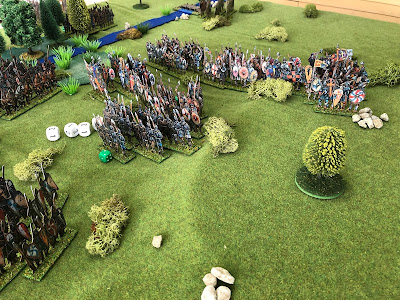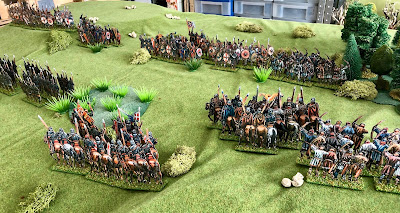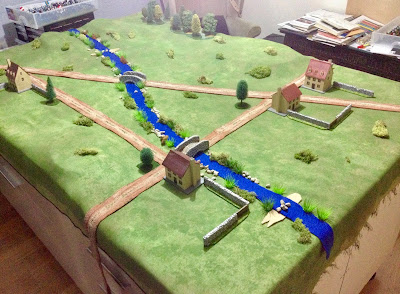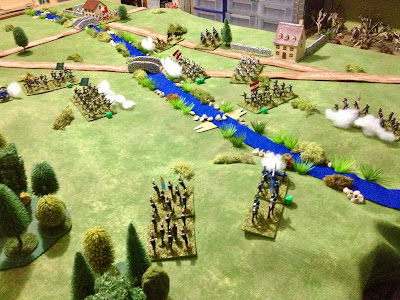Today I managed to complete preparing my map for a planned mini-WW2 campaign. I am using the map from the book "War Game Campaigns" chapter "Panzer Grenadiers vs. Guards" as a guide. I was going to redraw the map by hand to show a series of tabletops, but was able to copy and paste bits of the map into a campaign map.
Each square represents a 4x4 foot tabletop. The lines between square show where forces can move from one tabletop to another. Now I need to draw up the campaign rules.
On a completely different matter a couple of secondhand books arrived in the post today to add to my library.
Wednesday, 31 July 2019
Tuesday, 30 July 2019
Planning next projects
Having recently finished a couple of months clipping and snipping away to produce a couple of paper armies (Jacobite and 1066) it was time for a change. I had a box of GW Militarum Tempestus Scions stashed away, which while small in number would be a good filler activity while I ponder my next modelling or painting project. My options are to expand my Seven Years War armies, paint up some old Samurai figures mainly old Minifig's with a few other manufacturers thrown in, or add a few more units to my 19th Century Imagi-Nations armies.
On the wargaming side I plan to get back to and complete my English Civi War campaign which as languished for a couple of months as my focus was on making and playing with the paper soldier armies. However, my immediate gaming interest is to setup a WW2 mini-campaign using the Guards vs. Panzer Grenadiers campaign chapter from Donald Featherstone's "War Game Campaigns" book as inspiration.
The mini-campaign will use the book's map as a guide and create a point to point map where each point represents a 4x4 foot tabletop. The map will represent 6 tabletops by 6 tabletops and units will be ordered to move from point to point and when opposing units meet a game will be fought.
When playing the campaign the Panzer Grenadiers advance (from the top of the map downwards) will be determined by dice. While Guard movement will be via written orders which take effect the following campaign turn after being issued. This hopefully will present a challenge for the Guards (solo wargamer) player of trying to guess in advance the movements generated by the dice.
More on the campaign rules to come...
 |
| A few more figures representing security forces to add to my Necromunda style games using One-Hour Skirmish War-game Rules |
The mini-campaign will use the book's map as a guide and create a point to point map where each point represents a 4x4 foot tabletop. The map will represent 6 tabletops by 6 tabletops and units will be ordered to move from point to point and when opposing units meet a game will be fought.
 |
| Campaign map to use used as a guide |
More on the campaign rules to come...
 |
| Example of a 4x4 tabletop game |
 |
| A close up of a game in progress |
Saturday, 27 July 2019
Norman Conquest 1066 Game Report
Having spent a few evenings this week playing some quick test games to refine the D3 Norman Conquest 1066 rules. It was time to play a full game and provide a battle report. The updated rules can be accessed through a link at the top of page. A thank you to those who commented on the draft rules posted previously, they all got me thinking about the changes, which are:
So on to the game which is based upon scenario 12 "an unfortunate oversight" from the book One Hour Wargames. We have what appears to be an advance party of Norman cavalry and archers blocked from crossing the bridge by a Saxon force consisting of: 2 Housecarl units (one with their commander) 3 Fyrd units, and 1 archer unit.
Unbeknown to the Saxons the majority of the Norman force: 3 spearmen units and 1 cavalry unit (with commander) is fording the river out of sight behind the woods. The objective is to rout the opposing force or take the hill.
- No diagonal movement on the square gridded tabletop.
- Command actions simplified for movement, shooting and melee.
- Melee uses options for dice re-rolls rather than rolling multiple dice and selecting the highest.
- No differing unit elimination/routing numbers. All units rout at 7+ hits unless in defensive positions.
So on to the game which is based upon scenario 12 "an unfortunate oversight" from the book One Hour Wargames. We have what appears to be an advance party of Norman cavalry and archers blocked from crossing the bridge by a Saxon force consisting of: 2 Housecarl units (one with their commander) 3 Fyrd units, and 1 archer unit.
 |
| Game setup with Saxon and Norman forces deployed |
Turns 1 and 2
The first couple of turns see the Normans fording the river and pushing forward towards the hill. While the archers exchange volleys of arrows with their Saxon counterparts across the river. Other than one Fyrd unit left to defend the bridge, all other units rush to head off the Norman flanking force.
The command actions early in the game allowed for all units to move and archers to shoot.
 |
| The Norman flanking force ford the river. |
Turns 3 and 4
As both sides rushed for the hilltop the leading units soon clashed. Up to this point commanders were still choosing to use command actions to move units and shoot with their archers. By turn 4 the Normans had the bulk of their forces across the river.
 |
| Norman forces almost across the river and are about to clash with advanced Saxon units |
 |
| Normans attack |
Turns 5 and 6
As units engaged in melee fewer command actions were used to move units. Instead they were directed to galvanising units into second assaults and defensive efforts (re-rolling melee results).
 |
| The Saxon commander with Housecarl unit reaches the hilltop. |
Unfortunately I became somewhat absorbed in the game and forgot to take pictures of the turns 6 and 7.
Turns 7 and 8
During turns 7 and 8 both siders were heavily engaged in melee just below the hilltop. The Saxon commander and Housecarls were successfully defending the hilltop against a unit of Norman spearmen.
The Norman cavalry began to come into their own attacking weakened Saxon units and flanking the hilltop defenders. On turn 8 the Saxon commander was lost and all remaining Saxon units took 2 additional hits immediately with many units routing at the news. A victory to the Normans was assured.
 |
| The victorious Norman cavalry. |
I now need to cut out the Viking units to add to these paper armies.
Sunday, 21 July 2019
Saxons and Normans 1066 rules
Other than messing around with some 1066 Saxon vs Norman rules I have not had much time for wargaming or painting. So this post is really an update as to where I have got to with some rule ideas. I did start this week using rules for D6 dice and free movement and by week's end I was using D3 dice and a gridded tabletop. Anyway here are the draft rules and any thinking I have behind the rules which are influenced and based around One Hour Wargames Dark Ages rules and Dux Bellorum rules.
The rules use a square grid to control movement and shooting.
Combat used a D3 dice (1,1,2,2,3,3). Alternatively, you can halve the value of a D6 dice rounding up fractions.
All units exert a zone of control on all surrounding squares, including the diagonals.
Note: the zone of control is there to restrict movement in and around enemy units and make it difficult to flank units, which would extend their front is possible to avoid being flanked.
If a player has any carried over command actions they can reduce the number of hits on one or more of their units. No more than 1 hit can be removed from a single unit in a turn.
Note: this represents unit commanders reorganising their units, bolstering moral, filling any gaps in the shieldwall, etc.
Command actions are used by a player to move units and increase the ferocity of combat (see Melee for details).
Any command actions not used are carried over to the following turn and used to reorganise units.
If the commanders unit is lost only roll 1D6.
Note: I liked the leadership point rule in Dux Bellorum and adapted the concept of it for both movement and combat. It is more of a variable in these rules, in a way similar to PiPs in DBA.
At the end of their movement units must be facing one of the square sides.
Units may move diagonally between squares providing neither of the stranding squares are occupied by blocking terrain, a friending unit, or enemy unit’s zone of control.
Units may only exit an enemy unit’s zone of control, if the square to where they are moving is also an enemy’s zone of control.
Movement allowances:
Only 1 unit can occupy a square (no stacking of units) and units may not move through other units.
Units are allowed to turn and the start and/or at the end of their move. They must always end their move facing one side of a square.
It costs 1 command action for a unit to shoot.
Archers may only shoot at a single target within 45 degrees of their frontal facing side.
Archers roll a D3-1 when shooting. The result gives the number of hits the target acquires.
Note - there are no deductions for cover. Instead units can take additional hits before being eliminated. This way units holding defensive position tend to remain fast, as if they leave the position they lose the additional strength points.
Note: this represents unit exhaustion where unit leaders have to galvanise their men into attacking.
To determine hits the attacking unit rolls one or more D3 and selects the highest scoring D3. Units can roll an additional D3 for each of the following conditions:
Terrain Advantage - defenders on a hill increase they strength by 2 providing all attacking units are downhill.
Note: At present there are no advantages for Flank or Rear Attacks.
A units strength is increased by 2:
An attached commander remains with the unit throughout the game.
Note: hits can be removed during the reorganise phase.
 |
| Saxon Shieldwall |
Introduction
These are low complexity rules based upon and influenced by the rulesets One-Hour Wargaming Dark Ages rules and Dux Bellorum.The rules use a square grid to control movement and shooting.
Combat used a D3 dice (1,1,2,2,3,3). Alternatively, you can halve the value of a D6 dice rounding up fractions.
Units
The units represent the following:- Saxon Housecarl
- Saxon Fyrd
- Saxon Archers
- Norman Spearmen
- Norman Cavalry
- Breton Cavalry
- Norman Archers
All units exert a zone of control on all surrounding squares, including the diagonals.
 |
| Zones or control |
Sequence of Play
The game is played in a series of turns. During a player’s turn they follow the sequence listed below:- Reorganise
- Command
- Movement
- Shooting
- Melee
- Eliminating
Reorganise
If a player has any carried over command actions they can reduce the number of hits on one or more of their units. No more than 1 hit can be removed from a single unit in a turn.
Note: this represents unit commanders reorganising their units, bolstering moral, filling any gaps in the shieldwall, etc.
Command
Commanders roll 2D6 and select the highest score to determine their available command actions for the turn.Command actions are used by a player to move units and increase the ferocity of combat (see Melee for details).
Any command actions not used are carried over to the following turn and used to reorganise units.
If the commanders unit is lost only roll 1D6.
Note: I liked the leadership point rule in Dux Bellorum and adapted the concept of it for both movement and combat. It is more of a variable in these rules, in a way similar to PiPs in DBA.
 |
| A game in progress |
Movement
It costs 1 command action to move a unit. Units can move up their Movement allowance in squares.At the end of their movement units must be facing one of the square sides.
Units may move diagonally between squares providing neither of the stranding squares are occupied by blocking terrain, a friending unit, or enemy unit’s zone of control.
 |
| Movement constraints |
Movement allowances:
- Foot units move 1 square
- Cavalry units move 2 squares
Only 1 unit can occupy a square (no stacking of units) and units may not move through other units.
Units are allowed to turn and the start and/or at the end of their move. They must always end their move facing one side of a square.
Terrain
Terrain has the following effects:- Woods - Only Archers can enter and terrain advantage in melee.
- Towns - Only Infantry and Archers may end their moves in a town.
- Marshland and Lakes - These are impassable to all units.
- Rivers - These may only be crossed via bridges or fords.
- Hills - Terrain advantage in melee.
Shooting
Only archers can shoot and they have a range of 3 squares.It costs 1 command action for a unit to shoot.
Archers may only shoot at a single target within 45 degrees of their frontal facing side.
Archers roll a D3-1 when shooting. The result gives the number of hits the target acquires.
Note - there are no deductions for cover. Instead units can take additional hits before being eliminated. This way units holding defensive position tend to remain fast, as if they leave the position they lose the additional strength points.
Melee
Only attacking units inflict hits. Units automatically attack the unit directly in front of them when attacking. If they have more than 50% hits, then the attack is not automatic and they only attack at a cost of 1 command action.Note: this represents unit exhaustion where unit leaders have to galvanise their men into attacking.
To determine hits the attacking unit rolls one or more D3 and selects the highest scoring D3. Units can roll an additional D3 for each of the following conditions:
- They have a supporting unit on a flank
- An archer unit directly behind them
- A command action is spent.
Note: using lower quality units to support attacks rather than making attacks themselves keeps them out of harms way. While using command actions to add D3 represents a commander urging his unit on in an attack.
Terrain Advantage - defenders on a hill increase they strength by 2 providing all attacking units are downhill.
 |
| Saxon Fyrd's hilltop position increases their strength from 5 to 7 |
Eliminating
Units are eliminated once the number of hits acquired are greater than their strength. Different unit types have different strengths which can be increased if the terrain offers a good defensive position or they are accompanied by their commander.- Saxon and Norman Archers strength = 3
- Saxon Fyrd and Breton Cavalry strength = 5
- Norman Cavalry and Saxon Housecarl strength = 7
A units strength is increased by 2:
- if in cover or has terrain advantage against all attacking units
- If the commander is attached to the unit.
An attached commander remains with the unit throughout the game.
Note: hits can be removed during the reorganise phase.
Saturday, 13 July 2019
Saxons and Normans make it to the tabletop
Having finished the 1066 Saxon and Norman armies it was time to squeeze in a few quick games using One-Hour Wargame (OHW) and Dux Bellorum rules. Then finally trying a variation of the OHW rules using the leadership point ideas from Dux Bellorum. I like the approach with Dux Bellorum and will be going them another go soon.
However, the 1066 gaming ended as we have family visiting for a few days. The table was cleared so some Necromunda style One-Hour Skirmish Wargaming games could be played. The rules are simple and fun to play, and the family don't mind indulging me with a game or two.
 |
| The first trial game |
 |
| Another test game using the same terrain |
 |
| Necromunda style game |
 |
| Gun fire is exchanged |
 |
| The opposition |
Tuesday, 9 July 2019
19th Century Imagi-Nations Game
Over the last weekend I was able to play a 19th Century Imagi-Nations game. The main purpose for playing the game was to try out the smoke rule mechanism, where the effectiveness of shooting is reduced if the shooting unit fired in the previous turn.
To help determine the tabletop layout "Introduction to Battle Gaming" by Terry Wise provided the inspiration with its imaginary ACW battle of Centreville. However, a version of Centreville would be transposed to the disputed territory of Scailand where the Ustorian monarchy and the Novian states are fighting for control.
The order of battle was determined using the approach used in the chapter Wargaming Scenarios from "Wargaming Nineteenth Century" by Neil Thomas.
Ustorian Forces
Novian Forces
Ustorian forces start the game with an advantage in numbers, but must make that advantage count in the first 6 turns before the remaining Novian units arrive on one of their flanks.
A most enjoyable solo game. Ustorian forces were unable to use their small numbers advantage before Novian reserve arrived on the flank. As for the smoke rule mechanism? This worked out well, allowing fresh units entering combat get a definite advantage without it being overpowering.
 |
| A black and white photo midway through the game |
 |
| Tabletop layout |
Ustorian Forces
- 5 x Infantry
- 1 x Skirmishers
- 2 x Cavalry (reduced to 1)
- 2 x Artillery (reduced to 1)
Novian Forces
- 5 x Infantry (1 on flank move)
- 2 x Skirmishers (1 on flank move)
- 1 x Cavalry (flank move)
- 2 x Artillery
Ustorian forces start the game with an advantage in numbers, but must make that advantage count in the first 6 turns before the remaining Novian units arrive on one of their flanks.
 |
| Ustorian forces deployed |
 |
| Novian forces arrive |
 |
| The bulk of Ustorian forces are deployed on their left |
 |
| Both sides exchange fire along the river as both forces advanced |
 |
| The centre hill is pivotal to the Novian defence until their flanking units arrive |
 |
| Ustoran forces move across the bridge as their cavalry rush to the right flank to cross the river |
 |
| Ustorian forces line the river bank in an attempt to clear away Novian defenders. In the background Novian artillery can be seen repositioning to the centre hill after taking some punishing fire. |
 |
| Novian reserves arrive on the flank. While in the centre Ustorian cavalry having crossed the river charge into the forward Novian infantry. |
 |
| Ustorian cavalry charge in and will rout the Novian infantry. |
 |
| On the other flank Ustorian forces are repositioning their infantry to counter the Novian flanking force. |
 |
| The Novian centre is at risk even with additional support from their repositioned artillery unit. |
 |
| Novian flanking forces cross the river at a ford, and their cavalry rush to support a struggling centre. |
 |
| Novian centre forces are being whittled down. |
 |
| Ustorian forces desperately try to take the centre and bolster their right flank. |
 |
| Relief arrives for the Novian centre. |
 |
| Flanking Novian forces are looking threatening. |
 |
| The Novian centre holds it ground as the Ustorian attack begins to falter. |
 |
| Novian cavalry make short work of the defending skirmishers. |
 |
| It is all over for the Ustorian forces. |
Saturday, 6 July 2019
A bit of WW2 and 1066 this week
This weekend's wargame will be a 19th Century imagination game to try out the smoke modification to the rules (see previous post). However, most of my free time so far this weekend has been directed to completing my Normans and Saxons paper armies so I can have a game next week. Both armies have cost less than $60 to complete and were done as part of a challenge. I may have got the challenge wrong as I think the $60 limit was for a single army.
During the week a secondhand book I had ordered arrived - "World War II Desert Tactics" by Paddy Griffith. I found this an interesting read providing a useful overview of the tactics applied by the various armies from the start of the Desert war through to its conclusion. It got me thinking about the composition of forces I put on the tabletop, particularly the number of Anti-Tank guns used by Commonwealth and German forces.
 |
| The Norman paper army completed |
 |
| A close up |
 |
| A quick WW2 game based upon Tank on Tank rules during the week |
 |
| Recent book arrival |
 |
Subscribe to:
Comments (Atom)




